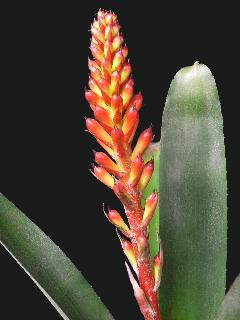
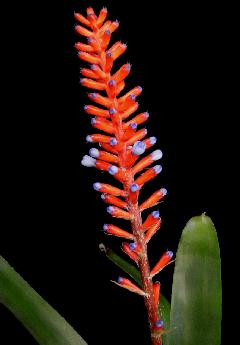
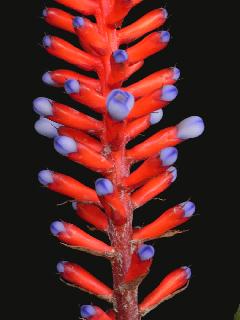
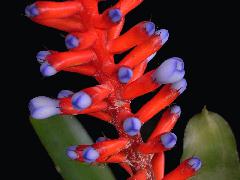
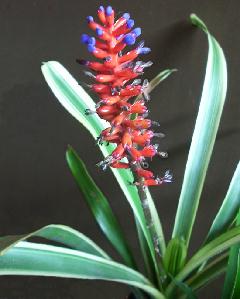
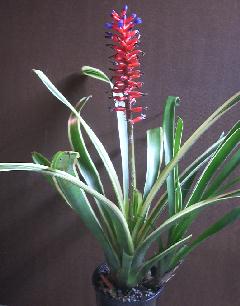
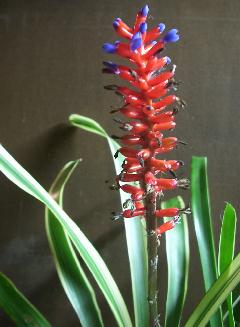
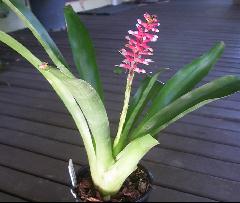
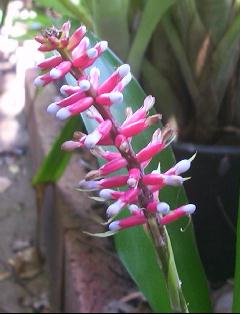
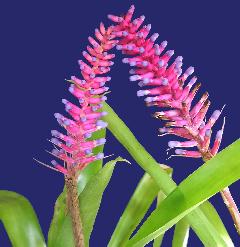
BRAZIL. Sao Paulo: Rio Tijuco, 3 Sep 1939, Foster 464 in part (US). Santa Catarina: Morro Iquererim, Campo Alegre, 9 Dec 1956, L. B. Smith & Klein 8497 (HBR, US).
From Bromeliaceas by Reitz 1983
7. AECHMEA APOCALYPTICA Reitz
GRAVATA
Est. 2
Reitz, Sellowia 14: 99, fig. 1. 1962; op. cit. 17: 45. 1965; op. Cit. 19: 101. 1987; Anais XV Congr. Nac. Bot. 238. 1987; L. B. Smith & R. J. Downs, Flora Neotropica 14: (3): 1882, fig. 641 A-B. 1979.
EPIFITO, acaule, 0,4m de altura. FOLHAS 10, rosuladas, fortemente convergentes embaixo formando utriculo; lamina rigida, recurvo-patente, canaliculado-concava, na margem com aculeos pe¬quenissimos (0,5mm), nao constrictas acima da bainha, de apice arredondado com acumen nao pungente, largamente linear, 25cm de compr., 2,5-3cm de larg., de ambos os lados levemente escamada, verde; BAINHA evidente, suboval, amplexicaule, inteirissima, densamente escamada, pouco enfeitada com estrias violaceas, 6cm de compr., 6cm de largura.
INFLORESCENCIA 14-floral, laxissimamente espigada (flores 0,5-lcm distanciadas entre si, dirigidas para qualquer lado), simplicissima, iniciando a antese na parte mediana; escapo inclinado, glabro, grossinho (4mm de diametro); foliolos muito poucos, tenros, roseos, por 3/4 amplexicaules, triangulares, de apice agudo, integerrimos, muito menores que os internodios, glabros, suberetos; raque geniculada, glabra, cilindrica, visivel, no apice superada pelas flores; bracteas estramineas, rubro-roseas, triangulares, de apice agudo, abracando o ovario por baixo, muito menores que os sepalos, longitudinalmente venosas, integerrimas, as inferiores 17 mm de comprimento, 11mm de largura na base, as superiores 5mm de compr., 5mm de largura na base. FLORES 21mm de compr., sesseis; sepalos roseos, glabros, ate a metade concrescidos em tubo depois livres, convolutos, o apice crescido em asa redonda, o apice em aculeo adunco 3mm de compr., mais ou menos de 10mm (com o aculeo) de compr., 5mm de largura; petalos azuis, eretos, no apice pouco abertos escondendo estames e estigma, no apice largamente arredondados, pouco emarginados, cuculado-concavos, totalmente livres, com 2 ligulas fimbriadas um pouco acima da base e com dois calos ascendentes; estames mais curtos que os petalos; filamentos interpetaleos livres, os epipetaleos contatos ate a altura das ligulas e depois presas entre os calos ate a metade da altura antera de 4mm de compr., dorsifixos pouco abaixo da metade; ovario 6-8mm de compr., 7mm de larg., subtrigono, roseo, glabro, no apice formado em tubo manifesto e infundibuliforme; estilete pouco menor que as anteras, pouco engrossado para o apice; estigma de lobos apenas contortos, placentas afixas pela metade interna dos loculos; ovulos muitos em um loculo, engrossados no meio, de apice obtuso.
Tipo - Brasil, Santa Catarina; Campo Alegre, perto da cidade, epifita nos capoes, 900m de altit., R. Reitz & R. M. Klein 4056 (06.09.1957), HBR.
Nomes vulgares - Gravata, monjola, bromelia. Dados fenologicos - Floresce em setembro.
Observacoes ecologicas - Planta epifita ou terricola, pequena, de aproximadamente 40cm de altura, folhas poucas (cerca de 10). rosuladas, fortemente convergentes embaixo formando receptaculo; bainhas evidentes, subovais, laminas rigidas, recurvo-patentes, canaliculado-concavas, na margem com aculeos pequenissimos, largamente lineares de aprox. 25cm de compr. por 2,5-3cm de larg.; inflorescencia sobressaindo em muito as folhas, em forma de espiga simples com poucas flores distanciadas entre si por 5 a 10mm, com calice roseo e corola azul; caracteristica dos capoes da borda oriental do planalto situados entre 800 e 1.200m de altitude, onde apresenta restrita, descontimua e inexpressiva dispersao.
Especie de luz difusa ou heliofita muito rara; desenvolve-se na orla e no interior dos capoes como epifita ou terricola ou talvez tambem nos subosques dos pinhais; da borda oriental do planalto, no alto da Serra do Mar, no extremo nordeste de Santa Catarina.
Material estudado - SANTA CATARINA: CAMPO ALEGRE: perto da cidade, flor, R. Reitz & R. M. Klein 4056 (08.09.1957), HBR, fotografada e desenhada em cor e preto; holotipo. GARUVA: Morro do Campo Alegre, terricola no campo sujo, 1200m, flor, R. Reitz & R. M. Klein 9787 (03.09.1960), HBR.
Area de dispersao - SANTA CATARINA: nos municipios de Campo Alegre e Garuva.
Translated by Butcher
EPIPHYTE, acaulous, height 0.4m.
LEAVES 10, rosulate, strongly convergent below forming an utriculum;
BLADES rigid, reverse curved-spreading, canaliculate-concave, the edges with very small spines (0.5mm), not constricted above the sheath, rounded apex with a non sharp tip, broad linear, 25cm long, 2,5-3cm wide, both sides slightly scaled, green;
SHEATHS distinct, suboval, amplexicaule, entire, densely scaled, a little decorated with violet grooves, 6cm long, 6cm wide.
INFLORESCENCE 14 flowered, spike very lax (flowers 0.5-lcm apart in all directions), simple, starting anthesis in the middle;
SCAPE sloping, glabrous, thick (4mm diam);
SCAPE BRACTS very few, tenuous, pink, 3/4 amplexicaule, triangular, with sharp apex, entire, much smaller than the internodes, glabrous, suberect;
RACHIS geniculate, glabrous, cylindric, visible, the apex exceeded by the flowers;
FLORAL BRACTS stramineous, ruby-red-pink, triangular, with sharp apex, including the ovary underneath, much smaller than the sepals, longitudinally veined, entire, the lower ones 17mm long, 11mm wide at the base, the upper ones 5mm long, 5mm wide at the base.
FLOWERS 21mm long, sessile;
SEPALS pink, glabrous, half connate in a tube later free, convolute, the apex with a round wing, the apex with a hooked spine 3mm long, more or less 10mm (with the spine) long, 5mm wide;
PETALS blue, erect, apex a little open, hiding stamens and stigma, the apex broadly rounded, a little emarginate, cuculate-concave, totally free, with 2 fimbriate ligules a little above the base and with two ascending callouses;
STAMENS shorter than the petals; interpetalous filaments free, the epipetalous connate to the height of the ligules and later positioned between the callouses to half the height of the anther 4mm long, dorsifixed a little below the middle;
OVARY 6-8mm long, 7mm wide, subtrigonous, pink, glabrous, the apex formed in an obvious tube and infundibuliform; style a little smaller than the anthers, a little thickened at the apex; stigma with just contorted lobes, placentas adhered on the inner half of the locules; ovules many in a locule, thickened in the middle, obtuse apex.
Type - Brazil, Santa Catarina; Campo Alegre, close to the city, epiphytic in the brush-wood, 900m alt., R. REITZ & R. M. KLEIN 4056 (06.09.1957), HBR.
Common names - Gravata, monjola, bromelia.
Phenological data - Blooms in September.
Ecological observations - Plants epiphytic or terricolous, small, about 40cm high, few leaves (about 10). rosulate, strongly convergent below forming a receptacle; sheaths distinct, subovate, blades rigid, recurved-spreading, canaliculate-concave, edges with small spines, broad linear ca. 25cm long, 2,5-3cm wide; inflorescence much exceeding the leaves, a simple spike with few flowers 5 to 10mm apart, with pink calyx and blue corolla; characteristic of the brush-wood of the eastern border of the plateau about 800 and 1.200m altitude, where it is restricted, discontinuous and an unknown dispersion.
Species of diffused light or very rarely heliophytic; it grows on the border and inside the brush-woods as an epiphyte or terricole or maybe also in the smaller pinetrees; on the eastern border of the plateau, in the heights of Serra do Mar, in the extreme northeast of Santa Catarina.
Studied material - SANTA CATARINA: CAMPO ALEGRE: close to the city, flowered, R. REITZ & R. M. KLEIN 4056 (08.09.1957), HBR, photographed and drawn in colour and black and white; holotipe. GARUVA: Morro do Campo Alegre, terricolous in a filthy field, 1200m, flowered, R. REITZ & R. M. KLEIN 9787 (03.09.1960), HBR.
Dispersion area - SANTA CATARINA: in the municipal districts of Campo Alegre and Garuva.